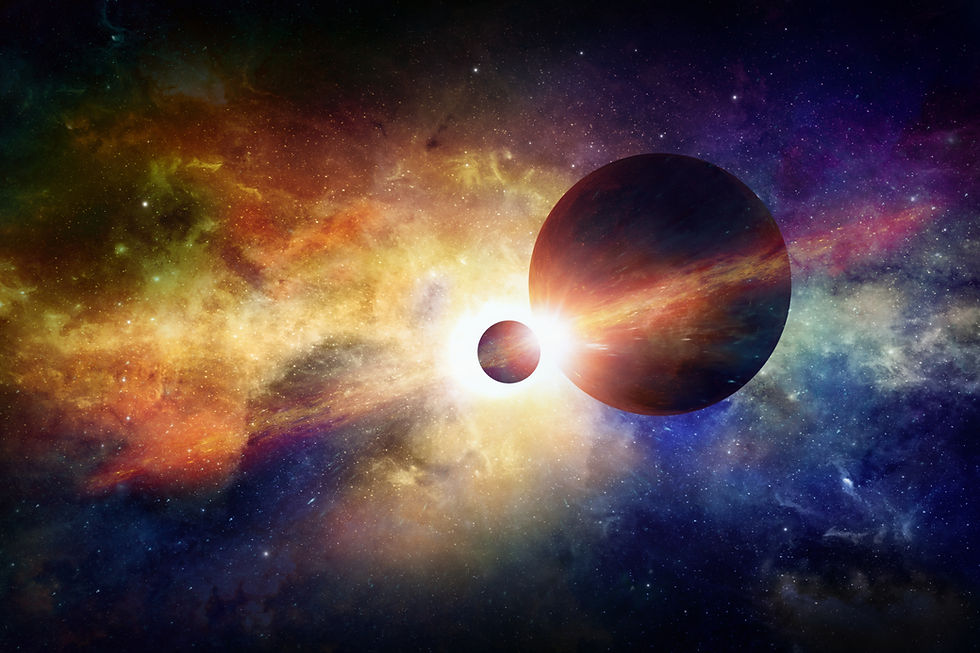WORLDBUILDING: The 3 Types of Story Worlds in Fiction
- M.L. Bull
- Aug 28, 2024
- 4 min read
Updated: Apr 5
Worldbuilding is the creative process of designing an imaginary world in fiction stories. As I mentioned in a previous post, there are three different forms of worldbuilding, including the physical environment, story worlds, and the various worldviews of our characters. Within fiction there are three types of story worlds that writers use in their novels or books. These include fantasy worlds, fictional worlds, and realistic or real worlds. Let's explore and quickly visit and examine all of these to see how they differ from one another below. 🔍

THE 3 TYPES OF STORY WORLDS
1. FANTASY WORLDS
This type of story world derives from the author or writer's imagination and usually in an exotic place or location that's non-existent in the real world. However, there may be some concepts incorporated with the story world that's based on real life. For example, evil vs. good, fighting for justice, or true love and friendship. Usually, fantasy worlds will also include fantasy terminologies, such as magic systems or fantasy creatures like dragons, monsters, witches, wizards, or other known fantasy trope characters.

2. FICTIONAL WORLDS
This story world takes place in a non-existent city or town, but in a real state, city, country, or island. For example, in my debut novel, Eva's Promise, the story takes place in a fictional town called Garden Ridge, but in the real state of North Carolina. Many famous authors, such as Stephen King also have written stories in fictional places located in real states. Just as fantasy worlds, real life concepts are usually included in fictional story worlds.
Fictional worlds can also be illusions of real life, such as utopia or dystopia worlds. Utopia worlds are pleasant and highly desirable societies, locations, or places where there is a sense of euphoria or complete paradise; while dystopia worlds are unpleasant and highly undesirable societies, locations, or places where there's much suffering and destruction.

3. REALISTIC OR REAL WORLDS
This type of story world is based solely on the real world and taken place in a real-life location, such as real cities, real states, real countries, or real islands or villages located in the real world. This story world usually also includes real, current, or past historical events that have taken place in the real world, such as well-known wars, the Great Depression, the Covid pandemic, or the Civil Rights movement.

HOW TO CREATE A STORY WORLD
When it comes to creating a story world, there are two things that can be helpful:
1. Make a story bible
2. Create a story map
WHAT IS A STORY BIBLE?

A story bible is a writing reference and collection of information based on the story world of a novel or book series. These bits of information can range from your characters' profiles and backstories to the geographical main setting of your story and other locales, to the laws, culture, and beliefs within the society of your story's world. All of this can go in a story bible.
Within your story bible, it can also be helpful to create a table of contents of everything that is listed inside of it. Writers can make their story bibles in various ways, such as in physical notebooks or binders with colored tabs, or in online or writing software programs, such as Campfire, Coda, Dabble, Hiveword, Notion, and Scrivener.
CREATING A STORY MAP

To create a story map, you can hire a professional designer on Fiverr Upwork, or another freelance website to make one for you as I did with my Underground Railroad Map for my Christian and Historical fiction novel, The Pact of Freedom. The map was made by a fantasy map designer named Nikola Jankovic from Serbia. Over our message interactions, he shared images of with me of the map during the creative process shown in the gallery below:
Or you can draw your own map for reference, as I did with Saint Vincent, New York, the fictional city neighborhood which my two series the Hallelujah Praise Trilogy and the Words by Heart Saga series both takes place. Saint Vincent is a fictional location that's actually based on Harlem, New York with a creative twist. I Googled Harlem, New York, created an outline of the city area and then filled in the rest of the locales and streets with my own imagination of Saint Vincent. This is something that writers could do if they're creating a fictional story world that's located in a real place.

💡Tip: USE WORLDBUILDING SPARINGLY. Worldbuilding is a fun and captivating creative activity, but make sure you don't get stuck there. Some writers who use worldbuilding go overboard and never actually write their novel or book series. Although worldbuilding is important to make your fantasy or fictional worlds believable to readers, probably 50% or more of your brainstorming won't actually be used within your story. Remember, this process is for reference purposes only and not meant for you as the writer to remain doing forever. Try to conjure up as much "needed" information as possible, and then go on from there and write your standalone novel or book series.
CLOSING REMARKS:

Okay, that's a wrap. By knowing the three types of story worlds, it allows you to properly identify their differences and some of the features expected within them. I hope this blogpost sparked your imagination and gave you a little inspiration in how you can design and use these story worlds in your own writing. If you found it helpful to you, please, give it a (heart❤️), take part in the poll🤔, and share your thoughts or comments 💬 below.)
Happy Writing! 😊✍🏽💻
🤔Which story world (s) have you used in your books or novels?
🐉 Fantasy Worlds ⚔️
🗺️ Fictional Worlds 📍
🌎Realistic or Real Worlds 🚦












Comments